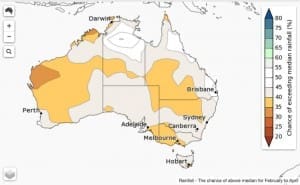Click on the image to watch video presentation of BOM’s seasonal climate outlook for February-April 2015
 The Bureau of Meteorology’s latest seasonal climate outlook continues to point to hot and dry conditions ahead for the remainder of summer and early autumn.
The Bureau of Meteorology’s latest seasonal climate outlook continues to point to hot and dry conditions ahead for the remainder of summer and early autumn.
BOM’s previous three monthly outlooks for the 2014-15 summer warned of drier than average conditions for most of Australia, however several areas of northern and eastern Australia have since received better than expected rainfall totals for the first two months of summer.
The BOM’s latest outlook says drier than normal conditions likely for much of Australia for the next three months.
In particular it is warning that the month of February shows a moderate to strong chance of drier than normal conditions for most of Australia.
“This signal persists across much of the country in March,” the outlook released this morning states.
“Warmer than average temperatures likely over most of Western Australia, New South Wales, inland Queensland and parts of South Australia.”
Climate influences include some residual warmth in the tropical Pacific Ocean, and a warm central Indian Ocean.
Night-time temperatures are also expected to warmer than normal normal over most of WA, western SA, and areas of both Queensland and NSW. Cooler than normal nights are favoured in an area to the south of the Top End of the NT.
The Bureau says that while the tropical Pacific Ocean hovered near El Niño levels for the last month or two of 2014, since the last week of the year the tropical Pacific has eased away from El Niño thresholds and has become more clearly neutral.
The Bureau says it is now expected to remain neutral for at least the next three months.
“Despite the relaxation away from El Niño thresholds, there is residual warmth across much of the tropical Pacific, which may be drawing clouds and moisture away from the Australian region.
“The waters across the central Indian Ocean are generally warmer than normal for this time of the year. The warm waters are not associated with the Indian Ocean Dipole (IOD), which is not present from December to April. Typically warmer than normal waters in the central Indian Ocean can influence conditions in western Australia and parts of eastern Australia at this time of year.
The drier than normal signal seen across much of the region is likely due to a decrease in cloudiness over much of the country, with February having the highest chance of a drier than normal month.”
Source: BOM
